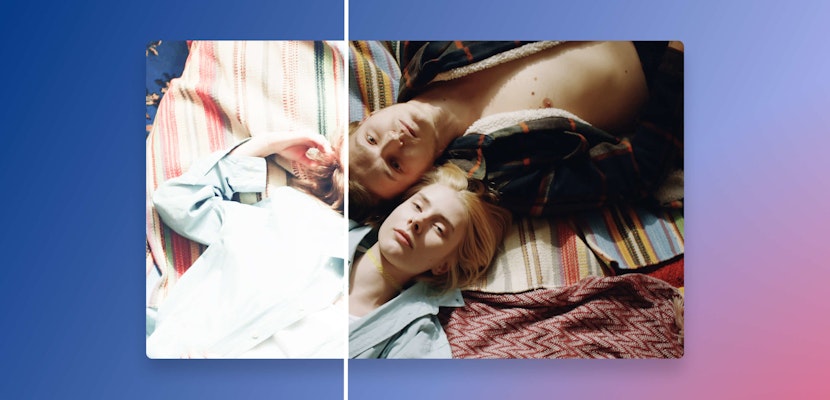Adding Snowfall to your videos is the ideal way of creating a wintery, magical look, and it only takes a couple of clicks to achieve. Today, we’re taking you through 3 incredible snowfall effects, from the realistic CC Snowfall to abstract motion backgrounds.
- Learn how to create a realistic Snowfall with After Effects CC Snowfall.
- Create incredible motion backgrounds and transition animations with Repetile and CC Particle World.
- Discover 3 incredible Motion Array Snowfall templates to save you time on your video projects.
Realistic snow using the CC Snowfall effect in After Effects
CC Snowfall is the After Effects snow simulation effect, and it is incredibly effective and super easy to use. CC Snowfall can be used to add a realistic covering of falling flakes across all of your projects.
- Place your footage in the Timeline and trim it to the required size.
- Right-click on the Timeline, then choose New > Solid.
- Select white for the Solid color and name it Snowfall.
- Go to the Effects Panel and search for CC Snowfall – add it to your Snowfall layer.
- Select the Layer in the Timeline and go to the Effects Control Panel.
- Uncheck the Composite with the Original box.
- Play around with the effects settings to adjust your snow effect’s size, depth, and speed.
Falling snowflake motion background patterns
Realistic snow is excellent for creating an animated or live-action composition, but what if you want to create a falling snowflake-style pattern for titles and backgrounds? After Effects has a handy little effect called RepeTile, making this task super straightforward.
- Create a composition in the size and duration you want your background pattern to be.
- Import a PNG of a snowflake that you want to use as the base of your pattern. Motion Array has some fantastic Snowflake template packs available to download.
- From the Project browser, right-click the snowflake graphic and choose New Comp from Selection.
- In the Snowflake Comp, select the snowflake image and hit R on your Keyboard.
- With the Playhead at the start of the Timeline, create a keyframe for the layer rotation.
- Move forward in the Timeline as long as you want the rotation to be and create a second keyframe.
- Adjust the rotation setting to +1.
- While holding ALT, click the Rotation Stopwatch in the Expression box on the Timeline and type loopout (‘cycle’).
- Play through your animation, adjusting the distance between keyframes to change the rotation speed.
- Go to your main background comp and drag the snowflake comp to the Timeline.
- Hit S to open the Scale Properties and rescale the flake to your desired size.
- Grab the snowflake in the Media Viewer and move it to the top of the screen until you can no longer see it.
- With your playhead at the start of the Timeline, hit P on your keyboard and create a Position Keyframe.
- Move forward around 10 seconds and drag the snowflake to the bottom of the screen.
- Play through your animation to check the speed and position – you can add more Keyframes to create a wiggle in the snowflake path.
- Go to the Effects Panel, search for CC Repetile, and add it to your snowflake layer.
- In the Effects Control Panel, adjust each of the Expand properties until your snowflakes fill the screen.
- Finally, choose from the Tiling drop-down menu to adjust how the repetition displays.
Top tip – You can also use 3D rotation on your snowflake graphic to create a spinning pattern.
3D snowflake-style particle snow effects
The final snowflake style we’ll show you is ideal for animated sequences, backgrounds, titles, and logo reveals. The fun, chunky 3D effect will surely get your audience in the holiday mood.
- Find a PNG of the snowflake design you want to use and Import it to After Effects.
- Drag the snowflake to your Timeline and make it invisible.
- Right-click on your Timeline and choose New > Solid.
- Go to the Effects panel and search for CC Particle World – add the effect to your Solid Layer.
- In the Effects control panel, change the Birthrate to .1 and the Longevity to 10.
- Go into the Producer settings and reposition the effect to sit above the frame.
- Change the Particle Type to a Textured Quadpolygon in the Particle settings and select the Layer to your snowflake PNG.
- Change the Birth Size and Death Size to 3 and the Opacity to 100%.
- Finally, go to the Physics tab and change the Animation Velocity to 12 and the Gravity to 0.05.
Top 3 snowfall effects available from Motion Array
If you don’t have the time to create snowfall, check out these stunning templates available to download from Motion Array today.
Cartoon Snowflakes Pack
The Cartoon Snowflakes Pack includes 18 stunning, hand-drawn motion effects ideal for animated videos, titles, and transitions. The fun collection includes falling snow, snowballs, and liquid splat shapes.
Snow Transitions and Backgrounds
The Snow Transitions and Backgrounds template pack includes 9 effects featuring quirky snowflake designs. Along with directional snowfall, the set features bursts and explosions, each with a color controller to create your own unique look.
Real Falling Snow
Motion Array also has a vast collection of snowfall overlays that can easily be added to your footage in any editing software. Real Falling Snow is a particular favorite, as the smooth movements and depth of focus give real Christmas vibes.
Snow is a fun effect to use in your projects, but more than that, it is incredibly useful. Creating snowfall effects doesn’t need to take long, but they can change the style of any video project to add a celebratory, seasonal feel. If you want to discover more snow effects, check out this incredible collection of 24 Merry and Bright Snow Backgrounds.



























